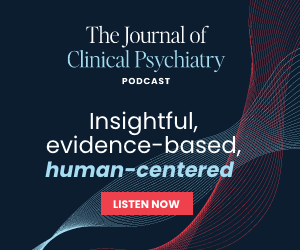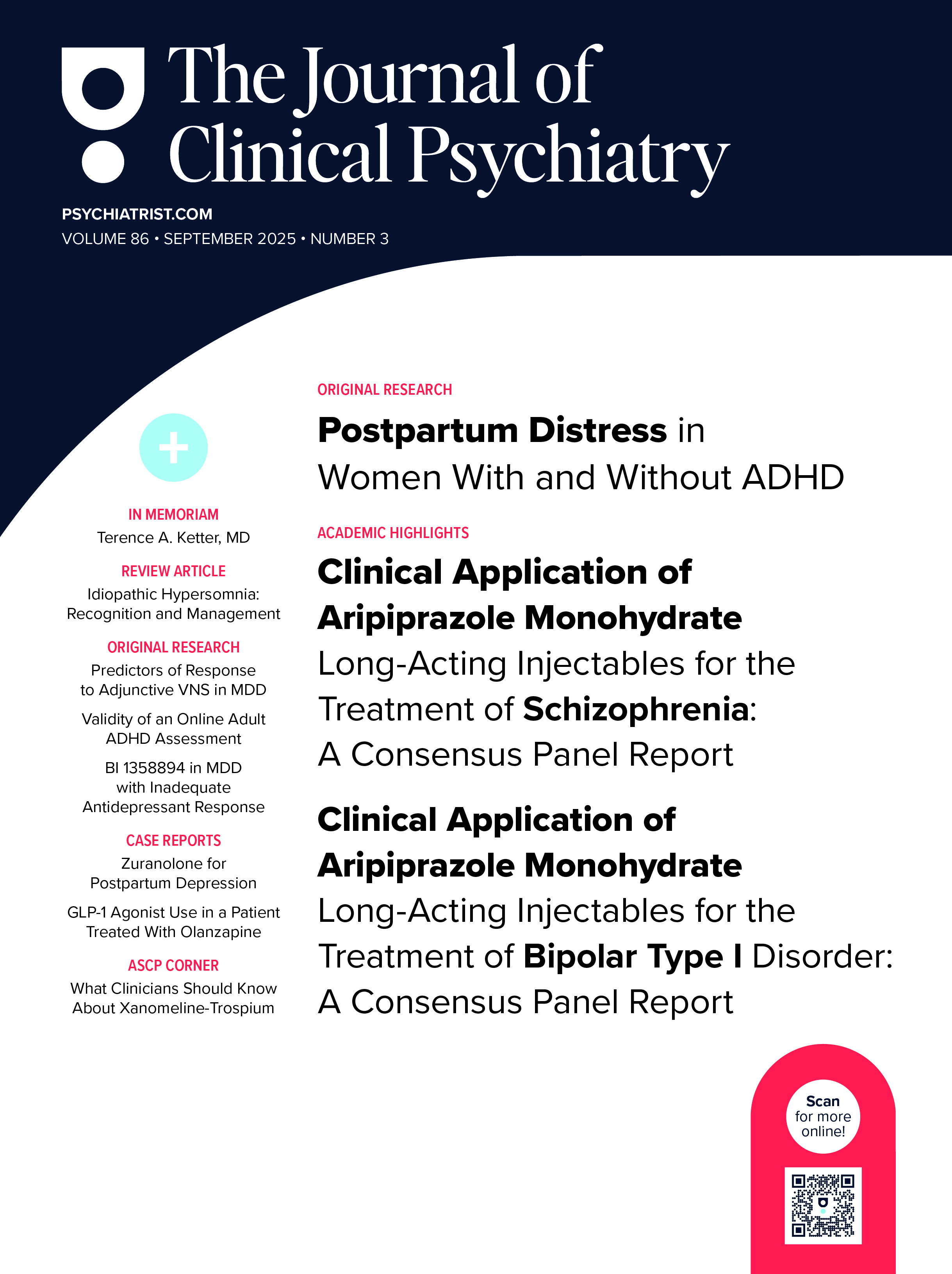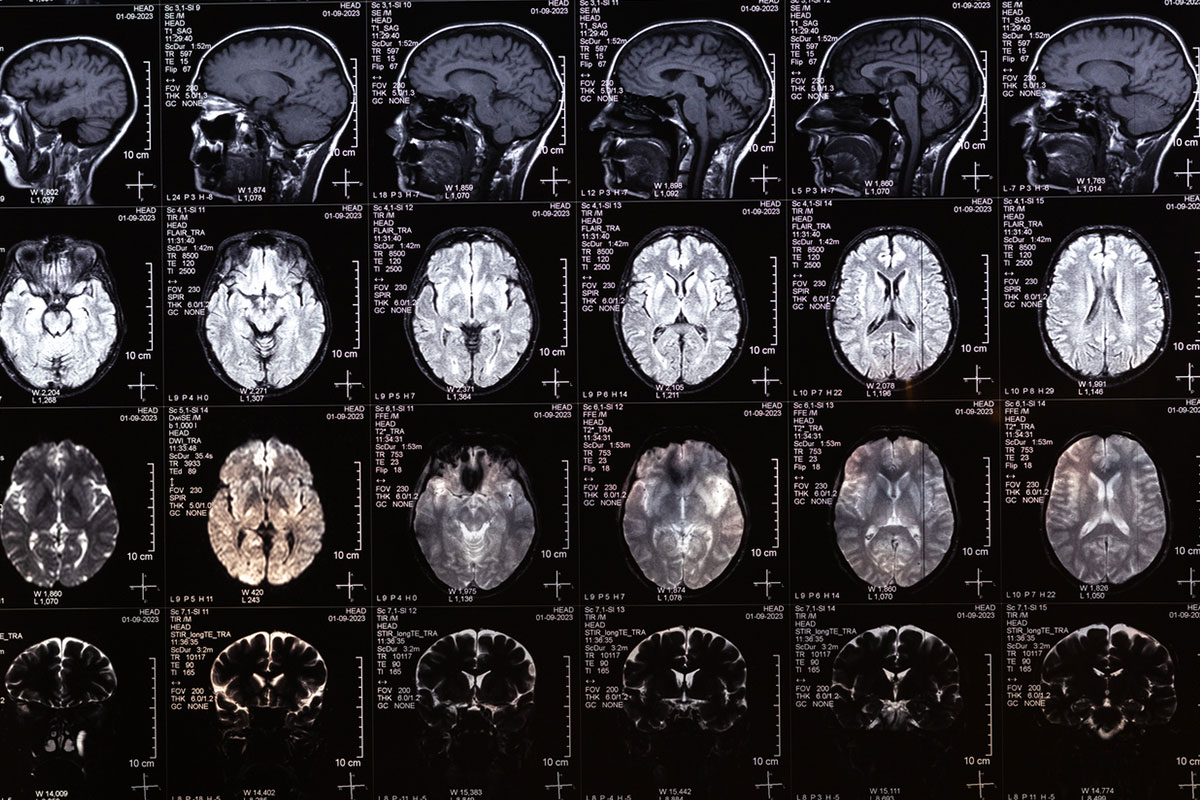Abstract
Background: Esmethadone is a novel N-methyl-D-aspartate receptor (NMDAR) uncompetitive antagonist in development as adjunctive treatment for major depressive disorder (MDD).
Methods: This 12-month, open-label study evaluated the safety and efficacy of esmethadone in patients with MDD meeting DSM-5 criteria who completed 1 of 3 double-blind studies (rollover) and in patients with MDD and no prior participation in esmethadone studies (de novo). Safety was assessed from adverse events, laboratory parameters, vital signs, electrocardiogram, and the Columbia-Suicide Severity Rating Scale. Efficacy assessments used measures of depression, anxiety, sleep, sexual function, cognitive function, and quality of life. The safety population comprised patients who received at least 1 dose of study drug, and the full analysis set (FAS) comprised patients who had at least 1 postbaseline efficacy assessment.
Results: Safety population included 624 patients; FAS included 586 patients (384 rollover and 202 de novo); mean age was 42.9 (13.6) years, and mean baseline Montgomery-Asberg Depression Rating Scale (MADRS10) was 34.5 (4.8). Most common treatment-related treatment emergent adverse events were headache (4.6%), nausea (4.2%), and dizziness (2.6%). There were no signals of meaningful neurological, cardiovascular, metabolic, or sexual adverse events and no case of suicide or suicidal attempt. For the FAS, mean (SD) change from baseline for MADRS10 at 3, 6, 9, and 12 months was −20.1 (10.7), −21.0 (10.8), −21.6 (10.7), and −21.6 (10.4). For the de novo population, mean (SD) was −19.9 (10.0), −19.9 (10.4), −20.1 (10.2), and −22.5 (9.7). Consistent improvements occurred with other tested efficacy measures.
Conclusions: Long-term treatment with esmethadone was safe and well tolerated. The antidepressant efficacy of esmethadone was sustained over 12 months.
Trial Registration: ClinicalTrials.gov identifier: NCT04855760.
J Clin Psychiatry 2025;86(1):24m15438
Author affiliations are listed at the end of this article.
Members Only Content
This full article is available exclusively to Professional tier members. Subscribe now to unlock the HTML version and gain unlimited access to our entire library plus all PDFs. If you’re already a subscriber, please log in below to continue reading.
References (51)

- Global Burden of Disease Study 2013 Collaborators; Barber RM, Bell B, et al. Global, regional, and national incidence, prevalence, and years lived with disability for 301 acute and chronic diseases and injuries in 188 countries, 1990–2013: a systematic analysis for the Global Burden of Disease Study. Lancet. 2015;386(9995):743–800. PubMed
- Hasin DS, Sarvet AL, Meyers JL, et al. Epidemiology of adult DSM-5 major depressive disorder and its specifiers in the United States. JAMA Psychiatry. 2018;75(4):336–346. PubMed CrossRef
- Fava M, Davidson KG. Definition and epidemiology of treatment-resistant depression. Psychiatr Clin North Am. 1996;19(2):179–200. PubMed CrossRef
- Moncrieff J, Cooper RE, Stockmann T, et al. The serotonin theory of depression: a systematic umbrella review of the evidence. Mol Psychiatry. 2023;28(8):3243–3256.
- Jakobsen JC, Gluud C, Kirsch I. Should antidepressants be used for major depressive disorder? BMJ Evid Based Med. 2020;25(4):130–136. PubMed CrossRef
- Boku S, Nakagawa S, Toda H, et al. Neural basis of major depressive disorder: beyond monoamine hypothesis. Psychiatry Clin Neurosci. 2018;72(1):3–12. PubMed CrossRef
- Henter ID, de Sousa RT, Zarate CA Jr. Glutamatergic modulators in depression. Harv Rev Psychiatry. 2018;26(6):307–319. PubMed CrossRef
- Mathews DC, Henter ID, Zarate CA. Targeting the glutamatergic system to treat major depressive disorder: rationale and progress to date. Drugs. 2012;72(10):1313–1333. PubMed CrossRef
- Hansen KB, Yi F, Perszyk RE, et al. Structure, function, and allosteric modulation of NMDA receptors. J Gen Physiol. 2018;150(8):1081–1105. PubMed CrossRef
- Nicoll RA. A brief history of long-term potentiation. Neuron. 2017;93(2):281–290.
- Cooper T, Seigler MD, Stahl S. Rapid onset brain plasticity at novel pharmacologic targets hypothetically drives innovations for rapid onset antidepressant actions. J Psychopharmacol. 2023;37(3):242–247.
- Correll CU, Solmi M, Cortese S, et al. The future of psychopharmacology: a critical appraisal of ongoing phase 2/3 trials, and of some current trends aiming to de-risk trial programmes of novel agents. World Psychiatry. 2023;22(1):48–74.
- Hanson JE, Yuan H, Perszyk RE, et al. Therapeutic potential of N-methyl-D aspartate receptor modulators in psychiatry. Neuropsychopharmacology. 2024;49(1):51–66.
- Johnston JN, Kadriu B, Kraus C, et al. Ketamine in neuropsychiatric disorders: an update. Neuropsychopharmacology. 2024;49(1):23–40.
- Krystal JH, Kavalali ET, Monteggia LM. Ketamine and rapid antidepressant action: new treatments and novel synaptic signaling mechanisms. Neuropsychopharmacology. 2024;49(1):41–50.
- Wang YT, Zhang NN, Liu LJ, et al. Glutamatergic receptor and neuroplasticity in depression: implications for ketamine and rapastinel as the rapid-acting antidepressants. Biochem Biophys Res Commun. 2022;594:46–56. PubMed
- Gorman AL, Elliott KJ, Inturrisi CE. The d- and l-isomers of methadone bind to the non-competitive site on the N-methyl-D-aspartate (NMDA) receptor in rat forebrain and spinal cord. Neurosci Lett. 1997;223(1):5–8. PubMed CrossRef
- Bettini E, Stahl SM, De Martin S, et al. Pharmacological comparative characterization of REL-1017 (esmethadone-HCl) and other NMDAR channel blockers in human heterodimeric N-methyl-d-aspartate receptors. Pharmaceuticals. 2022;15(8):997.
- Fava M, Stahl SM, Pani L, et al. Efficacy and safety of esmethadone (REL-1017) in patients with major depressive disorder and inadequate response to standard antidepressants: a phase 3 randomized controlled trial. J Clin Psychiatry. 2024;85(3):24m15265. PubMed
- Codd EE, Shank RP, Schupsky JJ, et al. Serotonin and norepinephrine uptake inhibiting activity of centrally acting analgesics: structural determinants and role in antinociception. J Pharmacol Exp Ther. 1995;274(3):1263–1270. PubMed
- Eddy NB, Halbach H, Braenden OJ. Synthetic substances with morphine-like effect: clinical experience; potency, side-effects, addiction liability. Bull World Health Organ. 1957;17(4–5):569–863. PubMed
- Henningfield J, Gauvin D, Bifari F, et al. REL-1017 (esmethadone; D-methadone) does not cause reinforcing effect, physical dependence and withdrawal signs in Sprague Dawley rats. Sci Rep. 2022;12(1):11389. PubMed CrossRef
- Pasternak GW, Pan YX. Mu opioids and their receptors: evolution of a concept. Pharmacol Rev. 2013;65(4):1257–1317. PubMed CrossRef
- Levinstein MR, De Oliveira PA, Casajuana-Martin N, et al. Unique pharmacodynamic properties and low abuse liability of the µ-opioid receptor ligand (S)-methadone. Mol Psychiatry. 2024;29(3):624–632.
- Soyka M, Zingg C. Feasability and safety of transfer from racemic methadone to (R)-methadone in primary care: clinical results from an open study. World J Biol Psychiatry. 2009;10(3):217–224. PubMed CrossRef
- Shram MJ, Henningfield JE, Apseloff G, et al. The novel uncompetitive NMDA receptor antagonist esmethadone (REL-1017) has no meaningful abuse potential in recreational drug users. Transl Psychiatry. 2023;13(1):192.
- Bernstein G, Davis K, Mills C, et al. Characterization of the safety and pharmacokinetic profile of d-methadone, a novel N-methyl-D-aspartate receptor antagonist in healthy, opioid naïve subjects: results of two Phase 1 studies. J Clin Psychopharmacol. 2019;39(3):226–237.
- Fava M, Stahl S, Pani L, et al. REL-1017 (esmethadone) as adjunctive treatment in patients with major depressive disorder: a Phase 2a randomized double-blind trial. Am J Psychiatry. 2022;179(2):122–131.
- Fogaça MV, Fukumoto K, Franklin T, et al. N-methyl-D-aspartate receptor antagonist d-methadone produces rapid, mTORC1-dependent antidepressant effects. Neuropsychopharmacology. 2019;44(13):2230–2238. PubMed CrossRef
- Hanania T, Manfredi P, Inturrisi C, et al. The N-methyl-D-aspartate receptor antagonist d-methadone acutely improves depressive-like behavior in the forced swim test performance of rats. Exp Clin Psychopharmacol. 2020;28(2):196–201. PubMed CrossRef
- De Martin S, Gabbia D, Folli F, et al. REL-1017 (Esmethadone) increases circulating BDNF levels in healthy subjects of a Phase 1 clinical study. Front Pharmacol. 2021;12:671859. PubMed
- Ferri N, De Martin S, Stuart J, et al. Drug-drug interaction studies of esmethadone (REL-1017) involving CYP3A4- and CYP2D6-mediated metabolism. Drugs R D. 2024;24(1):51–68.
- Hamilton M. A rating scale for depression. J Neurol Neurosurg Psychiatry. 1960;23(1):56–62.
- Desseilles M, Witte J, Chang TE, et al. Massachusetts General Hospital SAFER criteria for clinical trials and research. Harv Rev Psychiatry. 2013;21(5):269–274. PubMed CrossRef
- Chandler GM, Iosifescu DV, Pollack MH, et al. RESEARCH: validation of the Massachusetts General Hospital Antidepressant Treatment History Questionnaire (ATRQ). CNS Neurosci Ther. 2010;16(5):322–325. PubMed CrossRef
- Montgomery SA, Åsberg M. A new depressions scale designed to be sensitive to change. Br J Psychiatry. 1979;134:382–389. PubMed
- Posner K, Brown GK, Stanley B, et al. The Columbia-Suicide Severity Rating Scale: initial validity and internal consistency findings from three multisite studies with adolescents and adults. Am J Psychiatry. 2011;168(12):1266–1277. PubMed CrossRef
- Bremner JD, Krystal JH, Putnam FW, et al. Measurement of dissociative states with the Clinician-Administered Dissociative States Scale (CADSS). J Trauma Stress. 1998;11(1):125–136. PubMed CrossRef
- Treister R, Trudeau JJ, Van Inwegen R, et al. Development and feasibility of the misuse, abuse, and diversion drug event reporting system (MADDERS®). Am J Addict. 2016;25(8):641–651. PubMed CrossRef
- Busner J, Targum SD. The Clinical Global Impressions Scale: applying a research tool in clinical practice. Psychiatry (Edgmont). 2007;4(7):28–37. PubMed
- Hamilton M. The assessment of anxiety states by rating. Br J Med Psychol. 1959;32(3):50–55.
- Pedrelli P, Blais M, Alpert J, et al. Reliability and validity of the Symptoms of Depression Questionnaire (SDQ). CNS Spectr. 2014;19(6):535–546. PubMed CrossRef
- Sheehan DV. The Sheehan Disability Scales. In: The Anxiety Disease and How to Overcome It. Charles Scribner and Sons;1983:151.
- Yu L, Buysse DJ, Germain A, et al. Development of short forms from the PROMIS� sleep disturbance and Sleep-Related Impairment item banks. Behav Sleep Med. 2011;10(1):6–24. PubMed CrossRef
- Jaeger J. Digit Symbol substitution test: the case for sensitivity over specificity in neuropsychological testing. J Clin Psychopharmacol. 2018;38(5):513–519.
- Fehnel SE, Forsyth BH, DiBenedetti DB, et al. Patient centered assessment of cognitive symptoms of depression. CNS Spectr. 2016;21(1):43–52. PubMed CrossRef
- Atkinson MJ, Sinha A, Hass SL, et al. Validation of a general measure of treatment satisfaction, the Treatment Satisfaction Questionnaire for Medication (TSQM), using a national panel study of chronic disease. Health Qual Life Outcomes. 2004;2:12. PubMed CrossRef
- Ware JE, Kosinski M, Keller SD. How to Score the SF-12 Physical and Mental Health Summary Scales. 2nd ed. The Health Institute, New England Medical Center; 1995.
- Rabin R, deCharro F. EQ-5D: a measure of health status from the Euro-Qol Group. Ann Med. 2001;33(3):337–343. PubMed CrossRef
- Reilly MC, Zbrozek AS, Dukes EM. The validity and reproducibility of a work productivity and activity impairment instrument. Pharmacoeconomics. 1993;4(5):353–365. PubMed CrossRef
- McGahuey CA, Gelenberg AJ, Laukes CA, et al. The Arizona Sexual Experience Scale (ASEX): reliability and validity. J Sex Marital Ther. 2000;26(1):25–40. PubMed CrossRef





